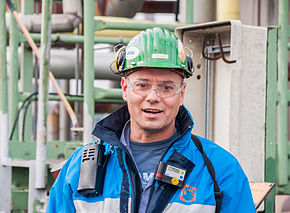Hard hat
His son, E. W. Bullard, returned home from World War I with a steel helmet that provided him with ideas to improve industrial safety.
[3] That same year, the U.S. Navy commissioned Bullard to create a shipyard protective cap that began the widespread use of hard hats.
Able to withstand high temperatures and radiant heat loads in the metals industry up to 350 °F (177 °C) without burning the wearer, it was also safe around high-voltage electricity.
Bakelite was used to provide protection rigid enough to withstand hard sudden impacts within a high-heat environment but still be light enough for practical use.
MSA also produced a low-crown version for coal miners known as Comfo-Cap Headgear, likewise offered with fittings for a headlamp and battery.
Strauss strove to create a safe workplace; hence, he installed safety nets and required hard hats to be worn while on the job site.
[citation needed] Today, most hard hats are made from high-density polyethylene (HDPE) or advanced engineering resins, such as Ultem.
Accessories such as face shields, sun visors, earmuffs, and perspiration-absorbing lining cloths could also be used; today, attachments include radios, walkie-talkies, pagers, and cameras.
Some contemporary cap-style hard hats feature a rolled edge that acts as a rain gutter to channel rainwater to the front, allowing water to drain off the bill, instead of running down the wearer's neck.
Organizations issuing hard hats often include their name, logo, or some other message (as for a ceremonial corner stone laying) on the front.
Many companies provide ready-made stickers to indicate that a worker has been trained in electrical, confined space, or excavation trench safety, as well as operation of specialized equipment.
A hard hat also provides workers with a distinctive profile, readily identifiable even in peripheral vision, for safety around equipment or traffic.
OSHA regulation 1910.135 states that the employer shall ensure that each affected employee wears a protective helmet when working in areas where there is a potential for injury to the head from falling objects.








